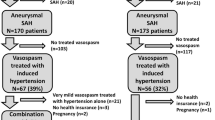Abstract
Objective
To report experience with intra-arterial (IA) calcium channel blocker (nicardipine) in patients with acute ischemic stroke with and without reteplase, mechanical thrombectomy (snare), and primary angioplasty to achieve maximal recanalization. Selective delivery of calcium channel blocker may improve perfusion and possibly provide neuroprotection in cerebral ischemia.
Methods
We performed a retrospective study to determine the angiographic and clinical outcomes among patients treated with IA nicardipine administered as 2.5–5 mg dose either alone or adjunct to intra-arterial thrombolysis. Mean arterial pressure and heart rate were recorded throughout the injection. Angiographic severity of initial occlusion and recanalization was assessed using the Qureshi grading scheme. Neurological examinations and computed tomographic scans were performed prior to, immediately, and 24 h after thrombolysis for each patient, to assess the neurological improvement and symptomatic or asymptomatic intracranial hemorrhages.
Results
Ten patients median age of 60 years (age range: 35–93 years) were administered IA nicardipine. The median admission National Institutes of Health Stroke Scale (NIHSS) score was 14 (range 6–19). All patients received IA nicardipine either in combination with thrombolytics (n = 6) or as monotherapy (n = 4). The average decrease in mean arterial pressure (MAP) was 10 mmHg; except one patient who had an asymptomatic decline of 34 mm Hg, which responded to fluid resuscitation. None of the patients suffered any procedural and post-procedural complication. Overall recanalization (improvement in one grade or greater) was observed in 2 of 10 patients with IA nicardipine with or without thrombolytic treatment. Other angiographic changes observed included improvement in collateral flow (n = 2), increase in transit time (n = 1), and vasodilation of distal arteries and branches (n = 4). No patient demonstrated any worsening from the baseline grade in response to IA nicardipine. Of the two patients who underwent serial magnetic resonance imaging (MRI) and one patient demonstrated reversal of pretreatment restricted diffusion. Neurological improvement defined by a decrease of four points or greater was observed in four patients at 24 h following treatment.
Conclusion
Intra-arterial delivery of nicardipine in doses up to 5 mg is well tolerated among patients with acute ischemic stroke. Further studies are required to determine the potential efficacy of this approach with or without thrombolytics.
Similar content being viewed by others
References
Sabbatini M et al. Neuroprotective effect of treatment with calcium antagonists on hypertensive retina. Clin Exp Hypertens 2002;24(7–8):727–40
Amenta F, Tomassoni D. Treatment with nicardipine protects brain in an animal model of hypertension-induced damage. Clin Exp Hypertens 2004;26(4):351–61
Kittaka M et al. Attenuation of brain injury and reduction of neuron-specific enolase by nicardipine in systemic circulation following focal ischemia and reperfusion in a rat model. J Neurosurg 1997;87(5):731–7
Mikami C et al. Effect of nicardipine and magnesiumon cerebral infarction–brain surface perfusion technique. Cerebrovasc Dis 2001;11(1):44–50
Flamm ES. The potential use of nicardipine in cerebrovascular disease. Am Heart J 1989;117(1):236–42
Rosenbaum DM et al. Pilot study of nicardipine for acute ischemic stroke. Angiology 1990;41(11 Pt 2):1017–22
Shiino A et al. [Ca++ antagonist and acute brain ischemia: effects of nilvadipine and nicardipine on middle cerebral artery occlusion in rats]. Nippon Geka Hokan 1991;60(1):38–44
Badjatia N et al. Preliminary experience with intra-arterial nicardipine as a treatment for cerebral vasospasm. AJNR Am J Neuroradiol 2004;25(5):819–26
Qureshi AI. New grading system for angiographic evaluation of arterial occlusions and recanalization response to intra-arterial thrombolysis in acute ischemic stroke. Neurosurgery 2002;50(6):1405–14; discussion 1414–5
Arnold M et al. Recanalisation of middle cerebral artery occlusion after intra-arterial thrombolysis: different recanalisation grading systems and clinical functional outcome. J Neurol Neurosurg Psychiatry 2005;76(10):1373–6
Flamm ES et al. Dose-escalation study of intravenous nicardipine in patients with aneurysmal subarachnoid hemorrhage. J Neurosurg 1988;68(3):393–400
Haley EC Jr, Kassell NF, Torner JC. A randomized controlled trial of high-dose intravenous nicardipine in aneurysmal subarachnoid hemorrhage. A report of the Cooperative Aneurysm Study. J Neurosurg 1993;78(4):537–47
Haley EC Jr et al. A randomized trial of two doses of nicardipine in aneurysmal subarachnoid hemorrhage. A report of the Cooperative Aneurysm Study. J Neurosurg, 1994;80(5):788–96
Acknowledgment
Dr. Adnan I. Qureshi is supported by National Institute of Neurological Diseases and Stroke (NINDS). Principal Investigator, Antihypertensive Treatment in Acute Cerebral Hemorrhage (ATACH) R01-NS44976-01A2. 2004–2006, $2,059,464.82.
Author information
Authors and Affiliations
Corresponding author
Rights and permissions
About this article
Cite this article
Shah, Q.A., Georgiadis, A., Suri, M.F.K. et al. Preliminary experience with intra-arterial nicardipine in patients with acute ischemic stroke. Neurocrit Care 7, 53–57 (2007). https://doi.org/10.1007/s12028-007-0035-7
Published:
Issue Date:
DOI: https://doi.org/10.1007/s12028-007-0035-7




